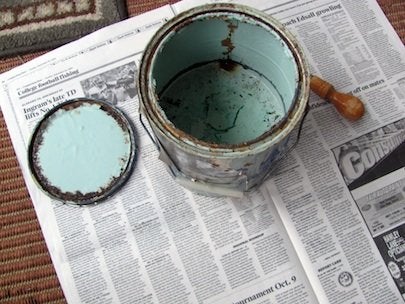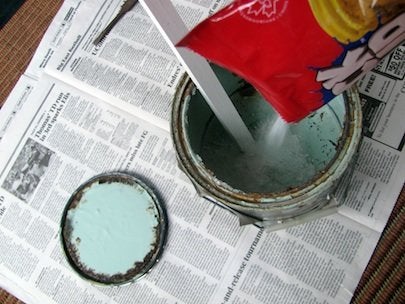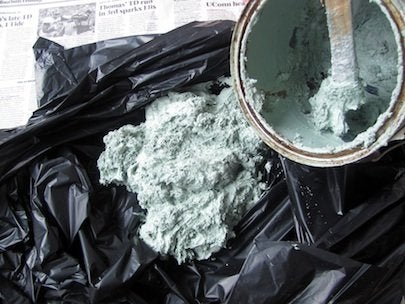Tuesday 27 January 2015
What to Do with Old Paint
Not sure what to do with old paint cans cluttering up your basement or garage? Follow this action plan to either condense or dispose of your surplus—and win back some valuable floor and shelf space in the bargain.

Leftover house paint is not the easiest stuff to get rid of. You can't simply throw it out without risking pollution and fines.
1. Determine if the paint is still good. Solvent-based paints have a 15-year shelf life. If you can stir it, it’s probably okay to use (even if you have to remove the “skin” on the surface first). Latex has a shelf life of 10 years. If it has been subject to freezing, it may not be usable. Test by stirring and brushing onto newspaper. If there are lumps, the paint is no longer good.
2. Decide what to keep. If the paints are in colors that are still on your walls, it makes sense to hang on to them. They will be useful for touch-ups and repainting when the time comes. If the lids are loose, seal them carefully; transfer small amounts in smaller containers. Be sure to label with color name, number and date of purchase.
3. Ways to use leftovers. Even if you’re sure the paint color is not one you’ll return to, consider mixing leftovers of the same paint type (latex with latex, acrylic with acrylic, oil with oil) to use as an undercoat primer.
4. Donate paints you don’t want. If you have good paint that you can’t use, offer it to family, friends and neighbors, or call a local paint contractor. Some charities may take paint too, especially those that do work helping the elderly with home renovations.
5. Dispose of what you can’t use and can’t give away. How you do it depends upon the type of paint, but it’s critical that it be done in a manner that won’t cause pollution to drinking water or waterways. One gallon of paint can contaminate many thousands of gallons of water, harm fish and aquatic plant life and eventually poison the food chain. Listed below are the proper ways to dispose of paint:

To solidify old latex paint, pour powder into the paint using the amount specified by the manufacturer and stir.
Latex and acrylic paints: Many municipalities will allow you to solidify these paints and throw them away with the household trash. One way to do this is to mix it with a clay-based cat litter at a ratio of two parts litter to one part paint. Do this in a well-ventilated place that’s off-limits to kids and pets. Another way is to use an additive. I tried XSORB’s Rock Solid and found that about a cupful turned the old latex paint in the photos to a solid after an hour.

Old paint gets an oatmeal consistency after only a couple of minutes of stirring.
Oil-based and alkyd paints: Check to see if there is a scheduled household waste collection day in your community (typically posted on your state’s Department of Environmental Conservation web site). You can also call your town hall. Bring paints to the specified collection site along with other toxic products you want to get rid of, such as paint removers, used solvents, pesticides, and herbicides.
If your community does not offer this service, call your County Extension Home Economics Agent, the local waste management agency, your area’s water treatment plant or the local landfill, and ask what the procedure is for where you live.
For more on paint and painting, consider:
Disposing of household paint and other hazardous household waste
Products such as paint, weed killers, pesticides, household cleaners and chemicals, creosote, fuel and other flammable liquids, motor oil, motor fluids, tyres, fluorescent tubes, etc, are all deemed hazardous and potentially damaging to the environment if disposed of incorrectly.
They should never be disposed of by placing in your normal rubbish bin or by tipping down the drain.
Try to avoid these products becoming waste in the first place. Check the guidelines on the tin to help ensure that you only buy enough of the product required for the job, and try and use up all of the product, for example, by spreading another coat to use up the last amount.
If you can't use it up yourself, see if your neighbours, friends, or relatives could find a use for it, or store it safely for future use, following the storage guidelines on the packaging.
Once completely empty, the containers of paint products and other chemical products may be placed in the normal rubbish bin.
Household waste recycling centres
Certain hazardous wastes can be taken to the household waste recycling centres for safe disposal. These include:
- Used engine oil.
- Domestic and vehicle batteries.
- Fluorescent tubes.
If you take these to the household waste recycling centres, they must be placed in the designated container.Do not take paint or any other hazardous waste to the household waste recycling centres as they will not accept any containers with paint or any other substance that is still in liquid form.
Vehicle tyres
Old vehicle tyres will be accepted by the fitting garage whenever they fit a new tyre to the vehicle. They may also accept additional old tyres though a disposal charge may be made for this.
Emulsion paint
In the case of emulsion paint, leave any left over paint that you will not use at a later date in the container with the lid left off and some sand added to it. When it is completely dry and is no longer in liquid form it can be disposed of in the normal rubbish bin. This does not apply to solvent based paint or to any other liquid hazardous waste.
Subscribe to:
Posts (Atom)